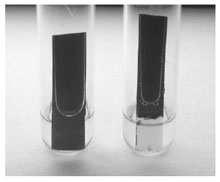The Activity of Gelatinase
Gelatin is a simple protein. When in solution, it liquefies at warm temperatures above 25°C. At room temperature or below it becomes solid. When bacteria that produce the enzyme gelatinase are grown in a gelatin medium, the enzyme breaks up the gelatin molecule and the medium cannot solidify even at cold temperatures. An alternative method for detecting gelatinase production is the use of X-ray film that is coated with a green gelatin emulsion. Organisms that produce gelatinase remove the emulsion from the strip.| Purpose | To observe the usefulness of a gelatinase test in distinguishing between bacterial species |
| Materials | Tubes of nutrient gelatin medium 1 X ¼-inch strips of exposed, undeveloped X-ray film or gelatin strip Tubes containing 0.5 ml sterile saline Slant cultures of Serratia marcescens and Providencia stuartii |
Procedures
- Inoculate each of the two cultures into a separate tube of gelatin, stabbing the inoculating wire straight down through the solid column of medium.
- Incubate the inoculated tubes and one uninoculated tube of gelatin medium at 35°C.
- Inoculate each of the two cultures into a separate tube of 0.5 ml saline. The suspension should be very turbid.
- Insert a strip of the X-ray or gelatin film into each saline suspension.
- Incubate the tubes at 35°C. Observe at 1, 2, 3, 4, and 24 hours for removal of the gelatin emulsion from the strip with subsequent appearance of the transparent strip support (see fig. 18.2).
- After 24 hours, examine the nutrient gelatin tubes. The uninoculated control as well as the two inoculated cultures should be liquid. Place all three tubes in the refrigerator for 30 minutes. If at the end of this period all tubes are solidified, replace them in the incubator. If any tube is liquefied but the others are solid, record this result.
- If tubes are reincubated, examine them every 24 hours, placing them in the refrigerator for 30 minutes each time, as in procedure 6.
 |
| Figure 18.2 Gelatin strip test. The organism on the left does not hydrolyze gelatin and, therefore, no clearing of the gelatin film is seen. On the right, the portion of the strip submersed in the organism suspension has cleared, indicating gelatinhydrolysis. |
Results
 |




